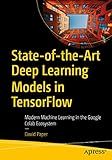Best TensorFlow API Resources to Buy in December 2025

Learning Deep Learning: Theory and Practice of Neural Networks, Computer Vision, Natural Language Processing, and Transformers Using TensorFlow



State-of-the-Art Deep Learning Models in TensorFlow: Modern Machine Learning in the Google Colab Ecosystem


The Estimator API in TensorFlow is a high-level API that makes it easier to build and train models. It provides an abstraction layer on top of the core TensorFlow functionality, allowing for quicker model development and easier debugging.
Using the Estimator API involves the following steps:
- Define the input function: This function will read and preprocess the input data. It typically returns a dictionary of feature columns and a tensor of labels.
- Define the feature columns: Feature columns are used to describe how to use the input data. These columns define the properties of each feature, such as its data type and any transformations to be applied.
- Create the Estimator: The Estimator is an object that represents the model. It provides methods for training, evaluating, and generating predictions. You need to specify the feature columns, the model function, and any necessary configurations when creating the Estimator.
- Create the model function: This function defines the architecture of the model. It takes the input features and performs the necessary operations to generate predictions. The model function should return a tf.estimator.EstimatorSpec object that includes the predictions, the loss function, and any necessary evaluation metrics.
- Train the model: To train the model, you call the Estimator's train method and provide the input function and the number of steps to train for. TensorFlow takes care of iterating through the input data and performing the necessary operations to train the model.
- Evaluate the model: After training, you can evaluate the performance of the model on a separate evaluation dataset using the Estimator's evaluate method. This method calculates and returns the evaluation metrics defined in the model function.
- Predict using the model: Once the model is trained, you can generate predictions on new, unseen data using the Estimator's predict method. This method takes an input function that returns the input data to make predictions on.
The Estimator API provides a streamlined workflow for building and deploying models. It offers flexibility, scalability, and abstraction that facilitate the development and deployment of various types of models in TensorFlow.
How to make predictions using a trained Estimator in TensorFlow?
To make predictions using a trained Estimator in TensorFlow, follow these steps:
- Create an input function to generate the feature tensors required for prediction. This function should return a tf.data.Dataset or a tuple of features and labels.
def input_fn_predict(): feature_placeholder = {"feature_name": tf.constant([value1, value2, ...])} return tf.data.Dataset.from_tensors((feature_placeholder, None))
- Load the trained Estimator model. You can either create a new Estimator object, passing it the necessary parameters, or load a pre-trained model.
estimator = tf.estimator.Estimator(model_fn=model_fn, model_dir=model_dir, params=params)
- Use the Estimator's predict method, passing the input function as the argument. This function will return an iterator over the predictions.
predictions = estimator.predict(input_fn=input_fn_predict)
- Iterate over the predictions and process or utilize them as required. For example:
for prediction in predictions: print(prediction)
Note: Ensure that the model_fn used for prediction is the same as the one used during training. The model architecture, input preprocessing, and output format should remain consistent for accurate predictions.
How to create an input function for evaluation data in TensorFlow Estimator API?
To create an input function for evaluation data in TensorFlow Estimator API, you can follow these steps:
- Define a function that returns a dataset for evaluation. This function should take no arguments and return a dataset object.
def eval_input_fn(): # Load or generate evaluation data eval_data = ...
# Convert evaluation data to TensorFlow dataset
dataset = tf.data.Dataset.from\_tensor\_slices((eval\_data\[0\], eval\_data\[1\]))
# (Optional) Perform any necessary preprocessing or transformations
return dataset
- In your model code, pass this function as the eval_input_fn argument when calling the evaluate method of the estimator.
estimator.evaluate(input_fn=eval_input_fn)
Make sure to replace estimator with your own estimator object.
By default, the evaluation input function will iterate through the dataset once. If you need more control over the evaluation process, you can define a custom evaluation loop using the Estimator.evaluate method.
What is a checkpoint in TensorFlow Estimator API?
In the TensorFlow Estimator API, a checkpoint is a saved snapshot of a model's parameters (weights and biases) during the training process. It allows you to save and restore the model's state, which is useful for many reasons such as:
- Resuming training from where it left off: If a training process is interrupted due to any reason (e.g., power outage, crash), checkpoints allow you to restart training from the point it was interrupted.
- Evaluating and comparing models: You can evaluate and compare the performance of different models on the same dataset by loading different checkpoints and running predictions.
- Serving trained models: Checkpoints are used to store the model's parameters, which can then be loaded and used for making predictions in a production environment.
Checkpoint files usually contain a prefix and a suffix, such as "model.ckpt-10000". The prefix represents the checkpoint name, and the suffix indicates the global step, which represents the number of parameter updates performed during training.
